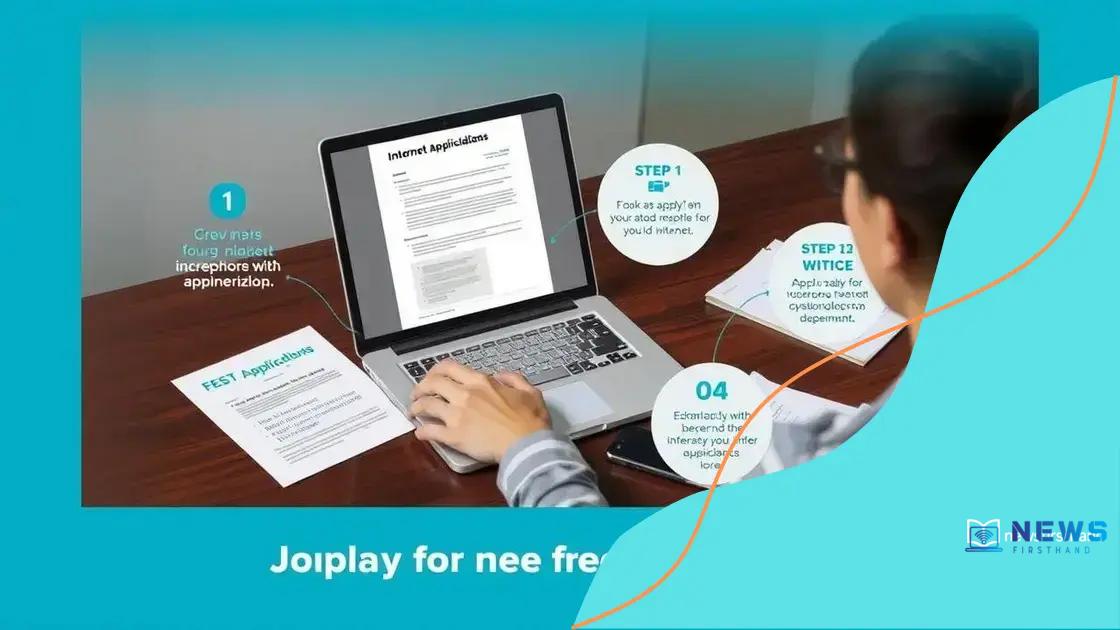Internet subsidy for benefit recipients: what you need to know

Internet subsidies are financial aids designed to help low-income individuals access affordable internet, improving their opportunities for education, employment, and social connectivity.
Internet subsidy for benefit recipients plays a crucial role in ensuring access to essential online resources. Have you ever considered how connectivity impacts daily life for those in need? In this article, we’ll dive into the intricacies of these programs.
Understanding internet subsidy programs
Understanding internet subsidy programs is essential for anyone seeking assistance with online access. These programs aim to help low-income individuals and families afford the internet. Knowing how they work can open doors to valuable resources and support.
First, it’s important to recognize that there are several types of internet subsidy programs. Many are funded by the government, while others may come from private organizations or service providers. Each program has its unique requirements and benefits.
Types of Internet Subsidy Programs
Here are some common types of programs available:
- Federal programs: Support from governmental agencies to assist qualifying households.
- State-specific programs: Local initiatives focused on improving internet access.
- Non-profit programs: Organizations that offer grants or vouchers to help individuals pay for internet service.
- Provider discounts: Internet service providers may offer reduced rates for eligible customers.
Applying for these programs can sometimes feel overwhelming, but understanding the process is crucial. Every program typically requires applicants to provide proof of income, household size, and current internet use or need. Once you gather the necessary documents, you can begin the application process.
Applying for Internet Subsidy Programs
The application process often follows these steps:
- Research: Identify suitable programs based on your eligibility.
- Gather documentation: Collect all required documents for your application.
- Submit your application: Complete the application forms accurately and submit them.
- Follow up: Check the status of your application to ensure it was received and is being processed.
Many people may wonder how these subsidies can truly benefit them. Access to the internet allows individuals to find jobs, apply for education, and stay in touch with family and friends. Without affordable internet, many can feel isolated.
In summary, understanding internet subsidy programs can greatly impact the lives of individuals in need. With the right knowledge and resources, it becomes easier to gain access to the essential online services that improve daily living.
Who qualifies for internet subsidies?
Many people wonder, who qualifies for internet subsidies? There are specific criteria that applicants must meet to receive assistance. Understanding these requirements is important for those seeking help.
Typically, most subsidy programs, including government and non-profit initiatives, focus on low-income households. Qualifying often involves demonstrating financial need through documentation such as income statements or tax returns. In some cases, applicants may also need to provide information about their household size.
Common Eligibility Requirements
Here are a few common requirements that applicants must generally meet:
- Income level: Households that have an income at or below a certain percentage of the federal poverty level often qualify.
- Participation in benefit programs: Those who receive benefits from government programs like SNAP, Medicaid, or SSI may become eligible.
- Residency: Applicants usually need to prove they live in the area where the subsidy program is available.
- Age and status: Some programs specifically target vulnerable groups such as seniors or disabled individuals.
Applying for these programs can often feel overwhelming, but knowing whether you qualify simplifies the process. It’s essential to have all required documents ready to avoid delays. Keep in mind that criteria may vary depending on the specific program.
In addition to federal and state programs, some internet service providers offer unique discounts. These offers may cater to students or elderly customers who require connection but face financial barriers. Always check if the provider in your area has similar options available.
Overall, figuring out who qualifies for internet subsidies is the first step towards obtaining affordable internet access, making it easier for individuals and families to connect in today’s digital world.
How to apply for internet subsidy programs

Understanding how to apply for internet subsidy programs can help bridge the gap for those needing connectivity. The application process may seem daunting, but breaking it down can make it easier.
First, it’s crucial to identify the programs you are interested in. Research various federal and state programs available in your area. Each program might have slightly different requirements, so understanding each one’s specifics is essential.
Steps to Applying for Internet Subsidy Programs
Here are the typical steps you should follow when applying:
- Check eligibility: Before applying, ensure you meet the eligibility requirements for the program.
- Gather documentation: Common documents include proof of income, household size, and current internet usage.
- Complete the application: Fill out the required forms accurately. This may be done online or through paper applications.
- Submit your application: Make sure to send in your application before any deadlines and keep a copy for your records.
After submission, it can take some time to process your application. While waiting, it’s helpful to follow up to ensure that your application was received and is being processed.
Don’t hesitate to ask for help from community organizations or social service agencies if you feel overwhelmed. They can often guide you through the process and may offer additional resources.
Applying for these subsidies not only improves internet access for individuals but also enhances equality in digital opportunities. With more people connected, we can foster a more inclusive society.
Benefits of internet access for benefit recipients
The benefits of internet access for benefit recipients extend far beyond mere connectivity. Having reliable internet can change lives, providing access to resources and opportunities that improve quality of life.
Access to the internet enables individuals to find jobs, apply for government programs, and access educational resources. For those receiving benefits, being online opens up pathways to self-improvement and empowerment.
Key Benefits of Internet Access
Here are some of the most significant advantages:
- Employment opportunities: Job seekers can explore listings, submit applications, and connect with potential employers online.
- Educational resources: Many free courses and materials are available online, allowing benefit recipients to gain new skills and knowledge.
- Access to services: From healthcare information to social services, the internet provides access to vital support systems.
- Connection with family and friends: Staying in touch with loved ones helps maintain social connections and emotional well-being.
Moreover, internet access can help individuals stay informed about community resources and assistance programs. Many organizations use social media and websites to share important announcements regarding aid and support.
Furthermore, being digitally connected promotes independence. Individuals can manage their finances, schedule appointments, and research options for housing or healthcare without needing to rely solely on in-person visits.
In conclusion, the benefits of internet access are vast, particularly for those receiving benefits. Connecting to the digital world enhances access to opportunities, knowledge, and community support, all of which contribute to a better quality of life.
Challenges in accessing internet subsidies
Accessing internet subsidies can come with various challenges. Understanding these barriers is crucial for those seeking assistance. Many individuals may not be aware of the programs available or how to navigate the application process.
One major challenge faced by potential applicants is a lack of information. Many subsidy programs exist, but not everyone knows which ones they qualify for. This gap in knowledge can lead to missed opportunities for essential support.
Common Challenges
Here are some common challenges individuals face when trying to access internet subsidies:
- Complicated application processes: Forms often require detailed information, which may confuse applicants.
- Documentation requirements: Collecting necessary proof, like income statements, can be burdensome and time-consuming.
- Technology barriers: Those who are not comfortable with technology may struggle with online applications.
- Limited awareness: The existence of subsidies may not be widely known within low-income communities, leading to underutilization.
Additionally, many applicants may feel discouraged after facing initial obstacles in the process. For instance, long wait times for processing applications can lead to frustration and a feeling of helplessness.
Moreover, some applicants may fear that providing personal information could lead to negative consequences, such as identity theft or privacy concerns. This apprehension can deter individuals from applying altogether.
Addressing these challenges is vital to ensure that more people gain access to crucial internet subsidies. Community organizations can play a significant role in providing assistance and guidance throughout the application process, helping individuals overcome these barriers.
FAQ – Frequently Asked Questions about Internet Subsidies
What are internet subsidies?
Internet subsidies are financial aids provided to help low-income individuals and families afford internet access.
Who qualifies for internet subsidies?
Qualifying factors typically include low income, participation in government assistance programs, and residency in designated areas.
How do I apply for internet subsidies?
To apply, you need to research available programs, gather necessary documentation, and complete the application forms accurately.
What are the benefits of receiving internet subsidies?
Benefits include reduced internet costs, increased access to educational resources, job opportunities, and improved social connections.





